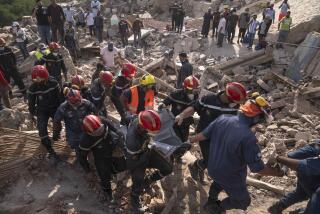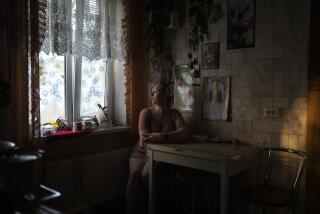In the Hills of the Shadow of Terror
- Share via
PRISTINA, Kosovo — What you see and what you hear in Kosovo is contradictory, shocking, disappointing--and in some ways hopeful. On arrival you know that both the U.N. Security Council and NATO have issued ultimatums. There is a possibility of a “military intervention” by NATO forces and the U.N. humanitarian groups are on a “Stage 3” alert. You hear the news that the Serbian parliament has been told by its leadership that the Kosovo “anti-terrorist” action has been completed and that there will be a military withdrawal from Kosovo.
At the same time, a U.S. diplomat describes the attacks on villages that took place the day before you arrive. That evening, an international diplomat tells you that he has spent the day at a site of a gruesome massacre, with old people and babies among the slaughtered.
The next day, you ride out into the countryside. Many houses are shell-pocked or their roofs are burned away. Villages are almost empty of people, and cow carcasses litter the road. With a UNICEF escort, you climb a rocky, muddy, twisting path. After a while, you see hundreds of people, mostly young children, walking around barefoot or in ripped sandals. Mud and feces are everywhere.
Families, many generations and cousins, are sleeping 15 to 20 to a tent. The tents are clear plastic and are given shape by bent saplings that create large tubes. The mothers are desperate to return home, which is just a few miles away down the canyon. Even if their houses are burned, they would rather sleep in the plastic tents in their own yards than up here in these completely inhospitable hills. But every time they try to return, snipers shoot at them, scaring them back.
They are worried about snakes that come at night. One woman who is nine months pregnant has had four forced moves in this summer of terror. She will have to give birth in this canyon. UNICEF later says that five of the 16 babies born in just this hilly region in the past few months died at birth.
There is no school, no latrine system, few clothes. People fled with what they were wearing in summer and have little food. The children have diarrhea from the dirty water and lack of sanitation. Two parents talk of how worried they are because their daughter was vomiting all night. The Mother Teresa Society, the local Albanian social service group, says food must be brought up the canyon at night or when it is foggy so the deliverers will not be shot by snipers.
Doctors who serve these families face loss of their careers and worse. We were told that a few days earlier, a doctor who had delivered babies for the women in the hills had been slain and his body mutilated. Yet there are still Albanian doctors willing to take the risk.
Snow and sleet and cold will soon be upon this terrorized population. The relief aid has been promised: food, blankets, temporary roofing materials, children’s shoes, sweaters and books. It is on the high seas, it is in the pipeline, it is promised. But it is not yet here.
Leaving, we meet several older women. They are carrying little buckets of milk. They have walked down this difficult path to their burned and pillaged village to milk their cows. They are carrying their precious cargo up that muddy, rocky path in little plastic pails. They say they have only minutes to milk before the snipers start their work.
Our last bit of news: An International Red Cross vehicle has hit a land mine. A doctor has died, not far away.
The news of the massacres is out. The U.N. Security Council is in emergency session. I hope that members have heard that despite all the outrages and the terror, there are few people here who think that air strikes alone can solve these problems. The babies soon to be born on those hills need political leadership to work out a way for them to be in their cradles safe at home.
More to Read
Sign up for Essential California
The most important California stories and recommendations in your inbox every morning.
You may occasionally receive promotional content from the Los Angeles Times.













